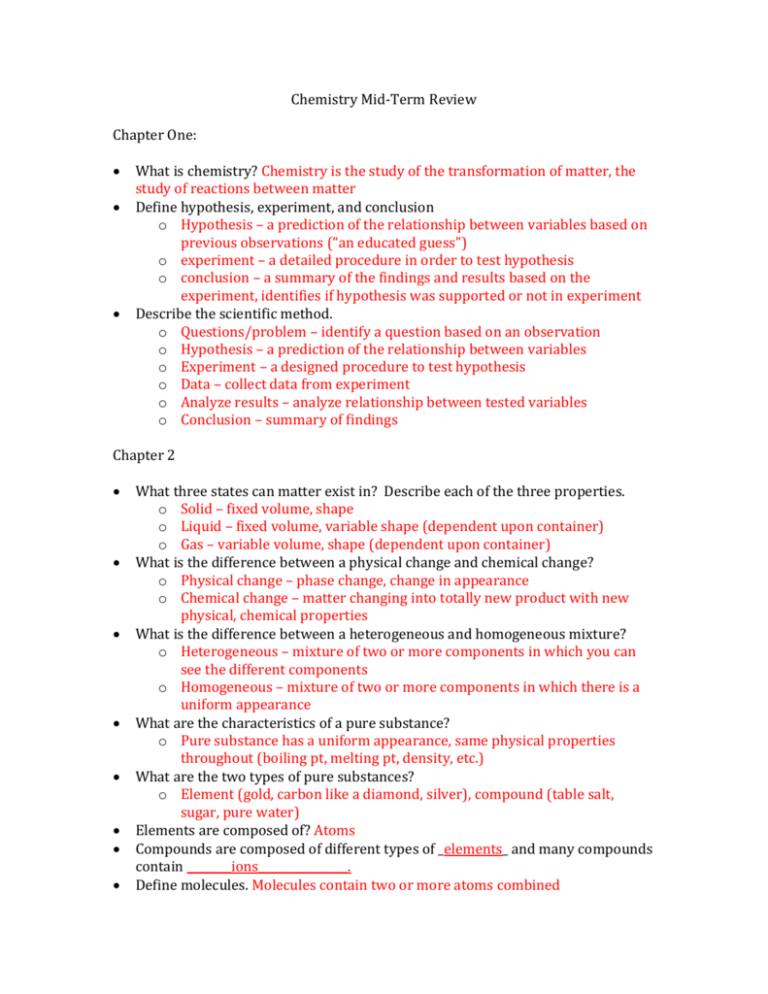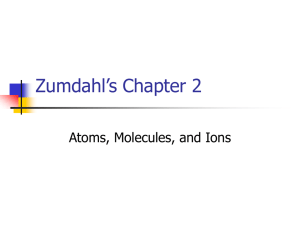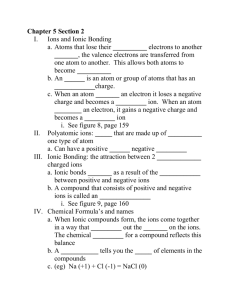Chemistry Mid-Term Review Chapter One: What is chemistry
advertisement

Chemistry Mid-Term Review Chapter One: What is chemistry? Chemistry is the study of the transformation of matter, the study of reactions between matter Define hypothesis, experiment, and conclusion o Hypothesis – a prediction of the relationship between variables based on previous observations (“an educated guess”) o experiment – a detailed procedure in order to test hypothesis o conclusion – a summary of the findings and results based on the experiment, identifies if hypothesis was supported or not in experiment Describe the scientific method. o Questions/problem – identify a question based on an observation o Hypothesis – a prediction of the relationship between variables o Experiment – a designed procedure to test hypothesis o Data – collect data from experiment o Analyze results – analyze relationship between tested variables o Conclusion – summary of findings Chapter 2 What three states can matter exist in? Describe each of the three properties. o Solid – fixed volume, shape o Liquid – fixed volume, variable shape (dependent upon container) o Gas – variable volume, shape (dependent upon container) What is the difference between a physical change and chemical change? o Physical change – phase change, change in appearance o Chemical change – matter changing into totally new product with new physical, chemical properties What is the difference between a heterogeneous and homogeneous mixture? o Heterogeneous – mixture of two or more components in which you can see the different components o Homogeneous – mixture of two or more components in which there is a uniform appearance What are the characteristics of a pure substance? o Pure substance has a uniform appearance, same physical properties throughout (boiling pt, melting pt, density, etc.) What are the two types of pure substances? o Element (gold, carbon like a diamond, silver), compound (table salt, sugar, pure water) Elements are composed of? Atoms Compounds are composed of different types of _elements_ and many compounds contain ________ions________________. Define molecules. Molecules contain two or more atoms combined Give three examples of heterogeneous mixtures and three examples of solutions that you may use in everyday life. o Heterogeneous – salt/pepper, dirt, oil/vinegar o Homogeneous – saltwater, Koolaid, air List three events that would be classified as a chemical change and three events that are classified as a physical change. o Chemical change – cooking an egg, burning a marshmallow, baking soda and vinegar o Physical change – breaking glass, painting a fingernail, ripping a paper Chapter 3 What are the three main parts of an atom? Proton, neutron (nucleus), electron Define an ion. Charged atom (cation – positively charged atom, anion – negatively charged atom) Define an isotope. Atoms that have the same number of protons, but different number of neutrons Identify the elements that are not represented by the first letter in their names on the periodic table. o Answers can include sodium (Na), potassium (K), gold (Au), silver (Ag) What is a compound? A combination of two more or different atoms that exist as ions Write the formula for each of the following substances, list the elements in the given order. o A molecule containing one phosphorous atom and three chlorine atoms. PCl3 o A compound containing one carbon atom and four bromine atoms. CBr4 Write the following in A/Z/X notation o Z = 8, neutrons 9 178O o Number of protons = 26, number neutrons = 31 5726Fe o Z = 3, number of neutrons 4 73Li Why are the elements of Group 8 referred to as the noble gasses? Noble, referring to being non-reactive with other elements Chapter 4 What is a binary compound? Two elements combined in a compound Name the simple binary compounds o NaI sodium iodide o SrO strontium oxide o CsI cesium iodide Write the name of each of the following ionic substances, using Roman Numerals to indicate the charge of the cation. o CoCl2 cobalt (II) chloride o PbO lead (II) oxide o Fe2O3 iron (III) oxide Write the name for each of the following binary compounds of nonmetallic elements (type 3). o NI3 nitrogen triiodide o SeO selenium monoxide o NH3 nitrogen trihydride, ammonia Give the name of each of the following polyatomic anions. o NO3-1 nitrate o ClO-1 hypochlorite o NH41+ ammonium o PO43- phosphate Write the formulas for the simple binary ionic compounds. o lithium oxide Li2O o silver oxide Ag2O o sodium sulfide Na2S HONORS ONLY: Memorize the polyatomic ions Chapter 5 Write the following as a decimal. o 6.235 x 10^-2 0.06235 o 8.621 x 10^4 86210 o 7.229 x 10^3 7229 Write the following in scientific notation o 0.000067 6.7 x 10^5 o 9,331,442 9.331442 x 10^6 Which distance is further 100m or 100km? 100 km 52.2mm is equal to how many cm? 5.22cm Identify the number of sig figs by drawing an underline below the sig figs. o 1422 - 4 o 65,321 - 5 o 200 - 1 o 0.0303 - 3 What is the different between rounding when you add or subtract, compared to when you multiply and divide? o Adding/subtracting – round to the lowest number of decimal places o Multiplying/dividing – round to the lowest number of significant numbers Chapters 7 and 8 (reactions) Balance the following equations o SiI4 + 4Mg -> 4Si + 4MgI o K2CO3 -> K2O + CO2 already balanced What are the major reaction types that we discussed? If we discussed a generic equation, make sure you include it. o Synthesis – A + B AB o Decomposition – AB A + B o Single replacement – A + BC AB + C OR A + BC AC B o Double displacement – AB + CD AD + CB o Combustion – CnHn+2 + O2 CO2 + H2O What are phase symbols and how are they used? o solid – s, liquid (l) , gas (g), aqueous solution (aq) What is the difference between a subscript and a coefficient? subscript identifies number of atoms, coefficient is the number of molecules How do you determine if a substance is soluble in water or not? use solubility rules What is the difference between word, skeleton, complete molecular, complete ionic, and net ionic equations? o word – names of compounds, elements involved in reaction o skeleton – chemical formulas of compounds involved in reaction o complete molecular – chemical formulas, with phase symbols and balanced o complete ionic – shows dissociation of compounds dissolved in water o net ionic – shows only ions involved in formation of precipitate o What are spectator ions? Ions that are not involved in formation of precipitate, “watching” ions o Write all of the above for K2CO3 -> K2O + CO2 o see board What is the net ionic equation for the reaction of a strong acid with a strong base? H+(aq) + OH-(aq) H2O(l) HONORS ONLY: Memorize the solubility rules Chapter 3 and 11 (atomic theories) Draw pictures of the following models of the atom. Label subatomic particles in each. o Dalton sphere, no subatomic particles o Thomson positively charged sphere with electrons randomly dispersed o Rutherford – sphere with nucleus at center containing protons, and electrons randomly dispersed o Bohr – solar system model, electrons orbiting nucleus contacting protons and neutrons Describe what Rutherford’s gold foil experiment was and what he discovered. Positively charged alpha particles shot at piece of gold foil. Particles that were reflected at different angles signified that at the center of the atom contained a dense, positively charged mass. This identified the location of protons in nucleus. Draw Electron Box Diagrams for each of the following o Mg o F o Ar Write shortcut notation of Electron Diagrams for each of the following o O [He] 2s22p4 o Cu [Ar] 4s23d9 o Pb [Xe] 6s24f145d106s2 Laboratory Equipment and Safety List four safety terms and their definitions. Examples can include: o Flammable – ignites in presence of heat or flame o Carcinogen – cancer causing agent o Toxic – can be fatal or cause serious injury o Mutagen – causes mutations of genetic material Explain what the following types of glassware are best used to do. o Beaker – hold/ heat liquids o Flask – measure liquids, hold/heat liquids o Glass rod –stir liquids o Watch glass – evaporation of liquid Pick three kinds of personal protective equipment we might use in the laboratory and explain why we would use them. o goggles – protect eyes o aprons – protect clothes o gloves – protect hands







